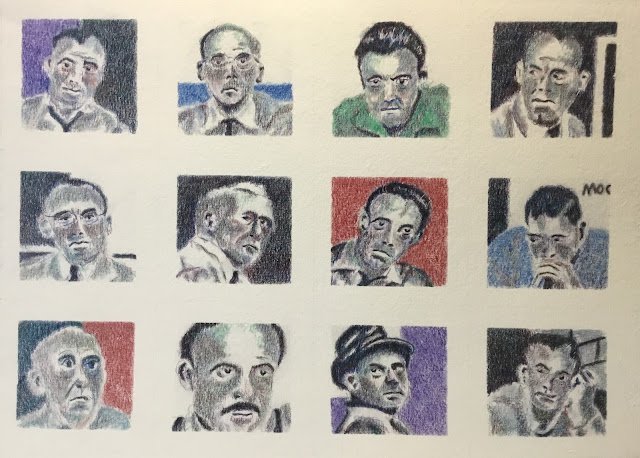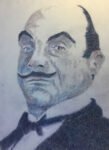It's still too cold to be out painting, so I'm indoors with the coloured pencils…

Twelve Angry Men
I saw this film on the telly the other day. Twelve Angry Men. It was released in 1957 and is a masterpiece. Twelve members of a jury debate a case and unanimously find the defendant not guilty after a vote at the start reveals an 11-1 majority in favour of guilty. The cast is pretty well restricted t9 these twelve actors and the location restricted to a meeting room. The twelve jurors all have different personalities and these personalities are revealed gradually rather than all being dumped on us at the beginning. It is a brilliant film and I decided pretty quickly after it had finished that it would make a good painting.
I started by carefully dividing up the paper and masking off twelve separate squares. I arranged my twelve source photos carefully, so that people were looking towards the middle of the painting rather than off the edges. Bit would have been easy to order the portraits in the same order that the jurors sat around the table but that wouldn’t have worked. It took me four days to complete the painting, doing three portraits a day.
I only used four colours, the same four as for David Suchet, and each colour was applied in two layers. So that was delft blue, then dark pthalo green, dark red and helio blue reddish, then all four again in the same order. The first couple of layers were only applied in the darkest places but I later applied colours in the mid-time areas and started applying more pressure in the dark areas. I added some background colours for variety and to create light/dark contrasts in places. After all twelve portraits were finished, I smoothed over the colours with a paper stump and removed the masking tape. And that was me done.
Let’s go through the twelve portraits, row by row and left to right:
1. Martin Balsam played the foreman. Not a great likeness but the jaunty tie makes him unmistakeable.
2. John Fiedler played the meek bank clerk. Again not a great likeness but it’s a good looking portrait, and there’s some personality coming through, albeit not necessarily the personality in the film. And his glasses, which I marked out with a pointy tool, came out well.
3. Edward Binns, one who stands up to bullies. I’ve got more of a likeness here and the highlights in t(e hair look great.
4. Henry Fonda, the film’s protagonist, the only juror to initially vote not guilty and the guy who convinces everyone else to switch their vote. There’s a bit of likeness there.
5. First in the second row is E. G. Marshall, playing a stockbroker who’s only interested in facts, not opinions. Quite close to a likeness. I should have left his glasses as white grooves on the paper rather than filling them in though.
6. Ed Begley played the racist. One of the best moments in the film is where he goes off on a bigoted rant and the other jurors get up one at a time, walk to the edges of the room and turn their backs in him. Not a great likeness but an interesting portrait.
7. Lee J. Cobb played a bully who had driven his own son out of his life. The juror most passionately believing the defendant was guilty. A great acting performance. Unfortunately this is the worst of the twelve portraits. No likeness, no personality, nothing interesting.
8. Robert Webber, the easily distracted creative type. A little bit of likeness there and a little bit of personality.
9. Joseph Sweeney, the wise old man. I’ve picked up part of the personality but not much likeness.
10. George Voskovec, the European immigrant. I’ve absolutely nailed the likeness and personality here, maybe because I’ve zoomed in a bit, leaving me with more room to work in.
11. Jack Warden, the wisecracking salesman who would rather be at the baseball game. Got a bit of Phil Collins going on there. The personality is on point though.
12. Jack Klugman as the guy who grew up in the slums. Not got the likeness or the personality but the is a personality of some sort there.
So the likenesses are in short supply. It turns out to be quite difficult to get likenesses on such a small scale. On the other hand, working on this scale does teach you something about portraits. You learn to look for what’s important and out this in every time. The line of the mouth, the shadow below the bottom lip, the nostrils, a couple of shapes on the ears, the shadow between the eye and the brow, simple u-shaped irises. I feel like I’ve become a better portrait artist at the end of this exercise. And, while individual portraits haven’t nailed the likenesses, the set of twelve has nailed the likeness of the jury. These four colours are great for monotone portraits and the combination of this paper, the four colours and the smoothing paper stumps, results in a blurry lack of focus that evokes old black-and-white films. Of course there’s colour too, making the portraits look like partly coloured in black and white stills.
This one’s going up for sale. To see the price, click here.








Leave a Reply